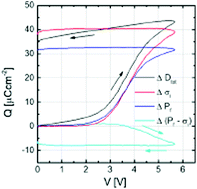Polarizing and depolarizing charge injection through a thin dielectric layer in a ferroelectric–dielectric bilayer†
Abstract
Charge injection from the near-by-electrode can occur during ferroelectric switching in the ferroelectric–dielectric bilayer due to the high field applied to the adjacent dielectric layers. The aim of this study is to investigate the effect of the charge injection by separating the amount of switched polarization and the injected charge density. A dynamic model of the injection-involved switching is developed and exploited to elucidate the mechanism. The model demonstrates that the amount of injected charges, which compensates for the bound charge of the polarization, can be larger, smaller, or identical to that of the polarization. This model further describes the analytical conditions of this compensation state. The model predictions are validated by the newly introduced ramping pulse measurements involving the serially connected TiN/Hf0.5Zr0.5O2/TiN and TiN/amorphous Al2O3/TiN, which are capable of separating the injected charge from the switched polarization. The dynamic model, along with the electrical measurements, enables the quantitative prediction and estimation of the internal potential and the effective charge, which is the sum of the bound and injected charges in the bilayer. This work provides fundamental insights into field-effect devices such as the next-generation ferroelectric-field-effect-transistors with NAND architecture based on uncompensated ferroelectric charges.



 Please wait while we load your content...
Please wait while we load your content...